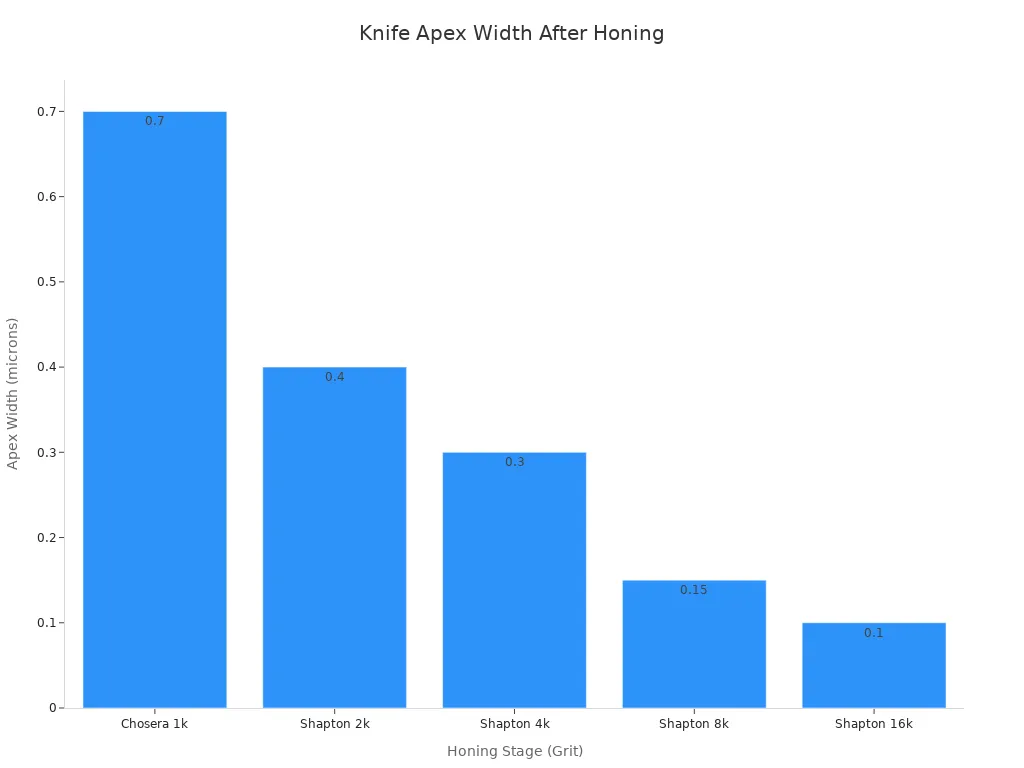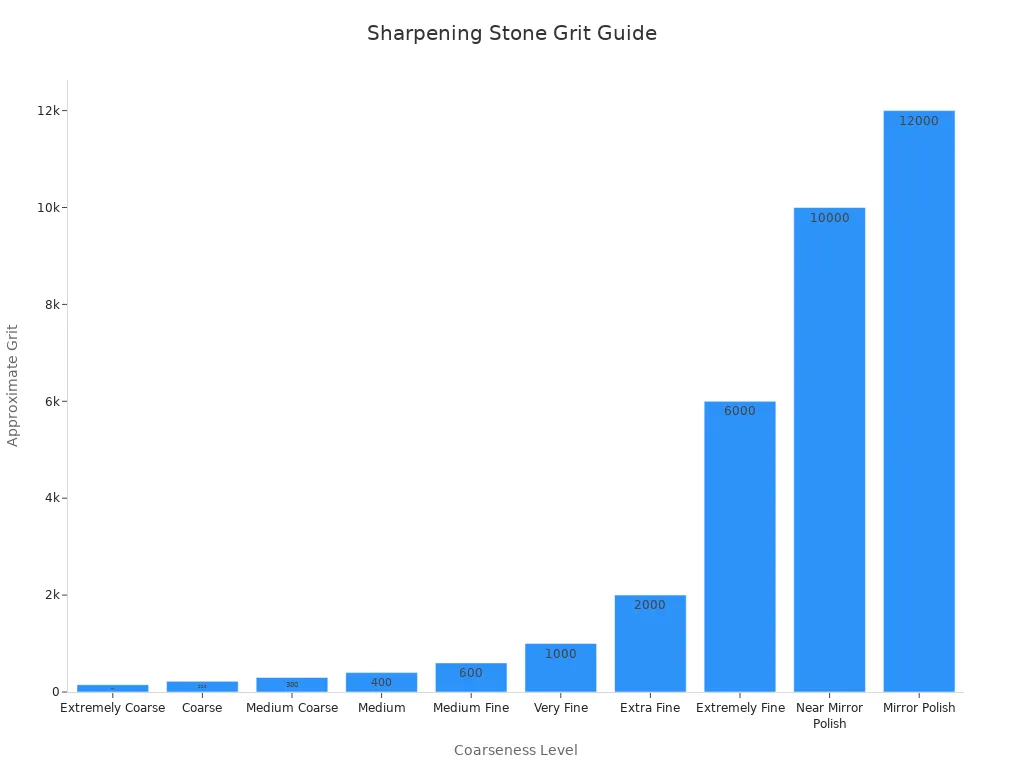You must understand the core difference between honing and sharpening. Sharpening removes metal from your knife to create a new, sharp edge. Honing, often done with a honing stone, simply realigns the existing edge.
Think of it this way: sharpening is like filing a new point on a dull pencil. Honing is like straightening that point if it gets bent.
Mastering both techniques is the secret to keeping a perpetually sharp knife.
Key Takeaways
- Sharpening removes metal from your knife. It creates a new, sharp edge when the knife is very dull.
- Honing straightens your knife’s existing edge. It keeps an already sharp knife working well.
- Sharpening is done rarely, like every few months. Honing is done often, even before each use.
- You use abrasive stones for sharpening. You use smoother rods or fine stones for honing.
- Both sharpening and honing keep your knife safe and effective. They are important for good knife care.
The Fundamentals of Sharpening

Sharpening is a corrective process. You perform this task when your knife is truly dull or its blade is damaged. Unlike honing, sharpening is about creating something entirely new on your knife.
The Goal of Creating a New Edge
The main goal of sharpening is to form a completely new, sharp edge. You achieve this by carefully grinding away a small amount of steel from the blade. This process removes the old, worn-out material. It exposes fresh steel and allows you to shape it into a fine, precise cutting edge. Think of it as a reset for your knife, restoring its original cutting power.
How Grinding Away Steel Works
You use an abrasive surface, like a whetstone, for the sharpening process. As you slide the blade across the whetstone, it removes microscopic layers of metal. This abrasive action reshapes the bevels of the knife until they meet at a fine point.
When to Sharpen Your Knife
Sharpening is an infrequent task. You only need to do it when your knife can no longer be improved by honing. If you notice any of these signs, it is time to get out your whetstone:
- The knife slips or slides off the surface of foods like tomatoes.
- You must apply more pressure to make cuts.
- Your cuts are messy or uneven.
- You can see visible nicks or chips on the blade.
How often you perform this task depends on your usage.
| User Type | Sharpening Frequency |
|---|---|
| Home Cooks | Every 1 to 3 months |
| Professional Chefs | Every few weeks |
Regular honing will extend the time between each sharpening session.
Honing for Daily Maintenance
If sharpening is a major reset for your knife, honing is the daily tune-up. You perform this task on an already sharp knife to keep it in peak condition. Honing is a maintenance process, not a corrective one. It ensures your blade performs perfectly every single day.
The Goal of Realigning the Edge
With regular use, the fine edge of your knife can bend or roll to one side. These imperfections are microscopic, but they make the knife feel dull. The goal of honing is to push this bent part of the blade back into perfect alignment.
This process extends the life of your knife by preserving its steel.
The Honing Rod vs. the Honing Stone
You might hear people use the terms honing rod and honing steel interchangeably. A honing steel is the classic tool for this job. However, a very fine-grit honing stone can also be used for honing. The key difference is the tool’s primary function.
| Feature | Honing Rod / Honing Steel | Sharpening / Fine Honing Stone |
|---|---|---|
| Primary Function | Realigns a bent or rolled edge. | Removes metal to create a new edge. |
| Material Removal | Minimal to none. | Significant (for sharpening). |
| Frequency of Use | Can be used daily. | Used less frequently. |
| Abrasiveness | Generally non-abrasive. | Highly abrasive. |
A honing steel straightens the existing edge, while a stone grinds a new one.
A Frequent Task for a Sharp Blade
You should make honing a regular habit. Many chefs give their knife a few passes on a honing steel before each use. This frequent maintenance keeps the edge perfectly straight and ready for any task. Honing ensures your knife is always at its best, delaying the need for a full sharpening session. As you use finer grits for honing, the apex of the knife becomes incredibly thin and sharp.

This chart shows how the knife’s edge gets progressively finer with higher grit stones, illustrating the refining power of a good honing process.
Honing vs Sharpening: A Direct Comparison
Understanding the honing vs sharpening debate is simple when you break it down. These two actions serve different roles in your knife care routine. One is a major operation, while the other is daily upkeep. Let’s compare them directly across four key areas.
Purpose: Create vs. Maintain
The purpose of each task is the most important difference.
- Sharpening creates a new edge. You perform this action when your knife is dull. The goal is to grind away the worn, rounded metal and form a fresh, sharp apex.
- Honing maintains an existing edge. You do this to a knife that is already sharp. The goal is to straighten a blade that has been bent or rolled out of alignment through normal use.
Think of it like this: Sharpening is the construction crew that builds the road. Honing is the maintenance crew that sweeps it clean and keeps it smooth for traffic.
Action: Removes Metal vs. Realigns Metal
The physical action on your blade is fundamentally different for each process.
Sharpening is an abrasive process. It physically removes steel to reshape the blade. Scientific studies show this happens in two ways:
- Nano-scale abrasion: This process softens and removes tiny particles from the very tip of the edge, making it keener.
- Micro-chipping: This action removes weak or damaged metal, clearing the way for a new, stronger edge to be formed.
A standard sharpening session on a dull knife removes about 1-10 microns of steel to restore the edge. However, using poor technique can accidentally remove 10 times more metal than necessary, shortening your knife’s lifespan.
Honing, on the other hand, is a process of realignment. It involves minimal to no material removal. Research shows that honing works through a process called burnishing or plastic flow. This action physically pushes the flexible, microscopic parts of the edge back into a straight line. It moves the metal without grinding it away, restoring sharpness without sacrificing steel.
Frequency: Infrequent vs. Frequent
Your usage determines how often you need to perform each task. Sharpening is done occasionally, while honing should be a regular habit.
You should perform sharpening only when your knife is truly dull and honing no longer works. For most people, this is an infrequent task.
| Your Knife Usage | Recommended Sharpening Frequency |
|---|---|
| Daily (Avid Cook) | Every 2–3 months |
| Weekly (Home Cook) | Every 6 months |
| Occasionally (Light Use) | Once per year |
Honing is a frequent maintenance task. Many chefs hone their knives before every use. This quick action keeps the blade perfectly aligned and ready to cut, extending the time between sharpening sessions.
Tools: Stone vs. Steel
You use different tools for each job because their purposes are so distinct. A sharpening tool must be abrasive, while a honing tool is much smoother.
The primary tool for sharpening is a stone. These stones are made from abrasive materials designed to grind away steel. For honing, the classic tool is a rod, often called a sharpening steel.
| Tool Type | Primary Materials |
|---|---|
| Sharpening Stones | Diamond, Ceramic, Natural stones (e.g., Arkansas) |
| Honing Steels | Standard steel, Ceramic, Diamond-coated steel |
While some fine-grit stones can be used for honing, their main job is abrasion. A true honing steel is designed specifically to realign your blade with minimal impact.
Choosing Your Sharpening Stones and Honing Tools
Selecting the right tools is crucial for effective knife care. Your choice of sharpening stones and honing tools will directly impact the quality of your edge and the lifespan of your blade. Let’s explore how you can pick the best equipment for your needs.
Selecting Quality Sharpening Stones
You need a quality whetstone for proper sharpening. A good whetstone provides a consistent abrasive surface to create a new, sharp edge. When you invest in a durable whetstone, you ensure better results and a safer sharpening process. The right tool makes all the difference.
Why Aimgrind Tools Offer an Edge
For top-tier results, you should consider specialized tools. Aimgrind is a brand focused on high-quality abrasive tools, including premium sharpening stones. Their products, made from materials like diamond, CBN, and aluminum oxide, offer great versatility. You can even use a fine-grit Aimgrind whetstone as a honing stone for maintenance. This makes their whetstone a great all-in-one knife sharpener solution.
Understanding Stone Grits and Materials
The “grit” of a whetstone tells you how coarse or fine it is. A lower grit number means a coarser whetstone, which removes metal faster. A higher grit number means a finer whetstone, which polishes and refines the edge. You should choose the grit based on your knife’s condition.
| Level | Description | Approximate Grit Range |
|---|---|---|
| 5 | Medium Fine – Good for initial sharpening of dull knives. | 400 – 600 Grit |
| 6 | Very Fine – Creates a sharp, frosted edge. | 600 – 1000 Grit |
| 7 | Extra Fine – Achieves a very sharp, polished look. | 1000 – 2000 Grit |
| 8 | Extremely Fine – Creates an extremely sharp edge. | 2000 – 6000 Grit |

For a very dull blade, you start with a coarser whetstone and move to a finer whetstone for honing and polishing.
Picking the Right Honing Rod
Your honing tool choice depends on your knife. The three main types are steel, ceramic, and diamond. Each has a different level of abrasiveness.
| Honing Rod Material | Abrasiveness | Effectiveness on Edges |
|---|---|---|
| Stainless Steel | Not abrasive | Most efficient for realignment |
| Ceramic | Less abrasive | Improved sharpness by ~50% |
| Diamond-coated | Most abrasive | Improved sharpness by ~30% |
Tip: For most daily honing, a standard honing steel is best because it only realigns the blade. For softer steel knives, a ceramic rod works well. Avoid diamond honing steels for regular use, as they are very abrasive and can damage your knife if used incorrectly.
You now understand that sharpening and honing are two vital skills for proper knife care. A sharp knife is a safe knife, reducing the force you need and preventing slips that can cause injury. Mastering both sharpening and honing empowers you to work more efficiently and safely in your kitchen. Embrace this rewarding skill.
Hone regularly to maintain your edge, and sharpen occasionally with a quality stone to restore it.
This simple routine will keep your favorite knife performing at its best for years to come.
FAQ
Can I use a sharpening stone to hone my knife?
Yes, you can use a very fine-grit sharpening stone for honing. A fine-grit stone, like those from Aimgrind, gently realigns the edge with a light touch. This action mimics a honing rod and helps maintain your blade’s sharpness without significant metal removal.
How do I know if my knife needs honing or sharpening?
Your knife needs honing if it feels slightly dull but still cuts. You should sharpen your knife when it is very dull, slips on food, or has visible nicks.
Remember: Honing maintains a sharp edge, while sharpening creates a new one.
Can I over-hone my knife?
Yes, you can damage your blade by over-honing. Using too much pressure or an overly abrasive tool wears down the edge faster. You should use a light touch and only a few strokes on each side to gently realign the blade.
Do I need both a sharpening stone and a honing tool?
Yes, you ideally need both for complete knife care. You use a honing tool frequently for maintenance. You use a sharpening stone occasionally to restore a dull blade. Owning both tools ensures your knife stays in top condition for years. 🔪
See Also
Understanding Dry Versus Wet Grinding: Essential Insights for Your Work
Exploring Grinding Wheel Varieties and Their Real-World Uses
Selecting Optimal Bench Grinding Wheel Materials for Specific Requirements
Picking the Perfect Grinding Wheel for Your Stainless Steel Projects
Finding the Ideal Grinding Wheel for Your Circular Saw Blades
Contact Us
For More Grinding Solution or Customized Abrasive Tools

